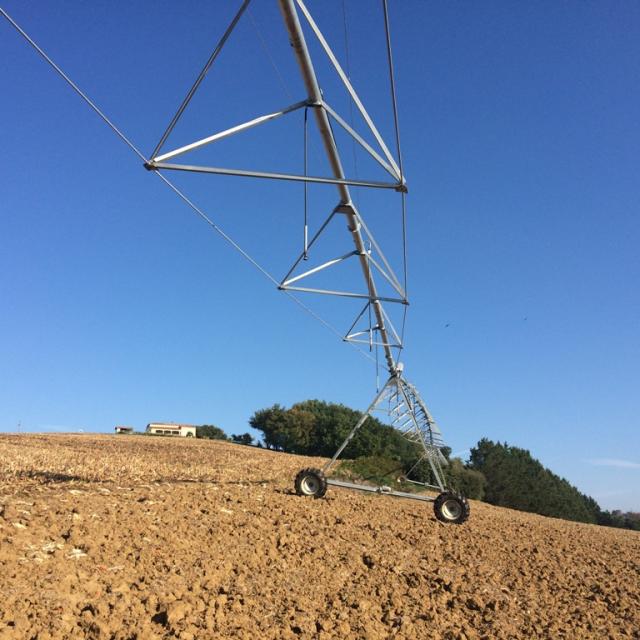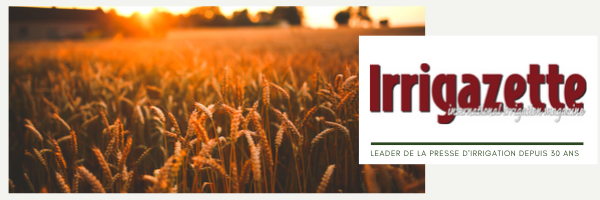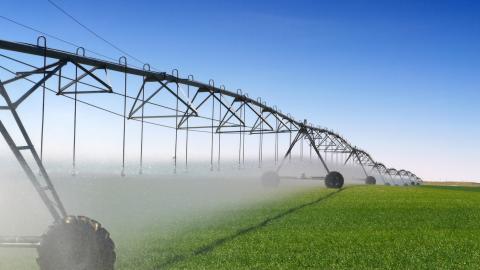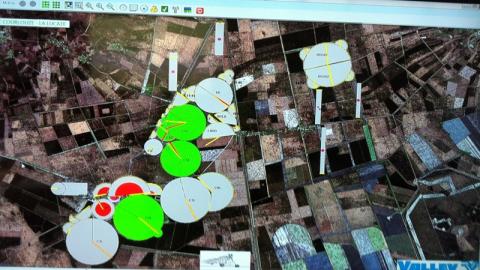On a pivot, the nozzles are fitted with a pressure regulator, allowing for a uniform pressure to be achieved across the whole field.

On a very fine morning in late September, in the company of Armel Morlet, Head of Valmont Irrigation in France, we set off for Mr. Farina’s farm at Leyritz-Moncassin, in the Lot-et-Garonne region. This place is located on the slopes of the Garonne valley. After travelling by road for an hour and a half through a beautiful landscape full of vineyards, we finally arrived at the farm.
Alain Farina welcomed us into the house. He was very busy that morning and could only spend about an hour with us. The farm is medium-sized and it has the peculiarity of only having sloping land. We got back into the car and drove off to see the Valley pivot recently acquired by Mr. Farina.
Once we arrived, we could see that the terrain was very steep: sixty metres difference in elevation between the highest and lowest parts of the field. The pivot seemed to be in a very precarious position and we wondered whether it was likely to topple over or give way. “The Valley pivots have spherical plain bearings (ball joint), making them very adaptable to operating on steep slopes, while still maintaining their sturdiness”, explained Armel Morlet.
Furthermore, the pivot, which has a 3.90 metre clearance between the ground and the span, has been raised one metre, allowing the tilt to clear the ground and pass over the crop canopy. Mr. Farina is considering extending the length of his pivot by one span as it is currently a little short. He has scheduled a meeting with his dealer so that they can come out and add another span.
Another problem with sloping land is trying to obtain a uniform pressure over all parts of the field. “There is a 60-metre difference in elevation between one end of the field and the other, representing a pressure differential of around 6 bar”, explained Mr. Farina. And he continued: “With a hose reel (traveling gun), I had to change the nozzle size. On a pivot, the nozzles are fitted with a pressure regulator, allowing us to have uniform pressure across the whole field”.
Another not insignificant advantage that the pivots have over the hose reels is that it is not necessary to go out to the field to move them, representing a considerable saving on time. In fact, Alain Farina is currently assisted by his father on the farm, but he may not always be willing and able and soon, perhaps, Alain will not be able to count on his help. If he finds himself working alone on the farm, he will not be able to find time to move the hose reel.
Thanks to the pivots, Mr. Farina has seen an increase in maize (corn) yields: “With the hose reels I was getting a maximum of 120 quintals (12 tonnes) of maize. I have managed to achieve 130 quintals (13 tonnes) this year”.
Thus, on his holding, our farmer is gradually replacing hose reels with pivots. He has bought another second-hand pivot in the Landes region, paying only 30% of the cost of a new pivot, which he installed himself. “It’s much cheaper than a new pivot but there’s always a risk”, he said. A third Valley pivot has been ordered.
To irrigate the two fields in the area where we were standing, Alain Farina draws water from the river that we could see in the valley below. He also has access to a private reservoir further away on the farm. He is also connected to two water supply networks.
“A single-crop system (monoculture) must be avoided because it has a harmful effect on the soil”
On his farm of 150 hectares, Mr. Farina adopts the practice of crop rotation. He alternates between rainfed crops and irrigated crops, because “when we don’t irrigate, we have a better soil structure”, he explained. On the field where we are standing, he has just harvested the maize and will be planting the wheat on 15th October. On the next field over, the opposite applies. It is currently cropped with wheat, which will soon be replaced with maize. Theoretically, wheat does not need irrigation, but, as an exception, “the pivot had to be used on the wheat this spring because it was very hot. Unfortunately, though, I was only able to irrigate half of the crop because I didn’t have enough water. The wheat yield has been 8 to 10 quintals down on previous years”, he laments. He also grows soya and rapeseed on his farm. “Rotation is very important because it allows for deep tillage of the soil. A single-crop system (monoculture) must be avoided because it has a harmful effect on the soil”.
Armel Morlet also mentioned to our farmer the importance of a nozzle plan and the fact that the quality and uniformity of the irrigation should be the criteria used when selecting a sprinkler. This choice and positioning of the sprinklers on the spans must take into account the soil water status and the form of crop management applied to the extent that the overlap of the sprinklers is sufficient to ensure that no irregularities in the uniformity of the irrigation occur during a dry summer. The quality of the sprinklers, their assembly and position and adjustment vis-à-vis the span will, of course, have an influence on the proposed budget. Here, in this case, the pivot is fitted with Nelson sprinklers positioned, with drop tubes, approximately every 5.75 m. This is a spacing that is quite acceptable for Mr. Farina, who is satisfied with the quality of irrigation and the way the sprinklers are installed.
“Irrigation is expensive, about €300 per hectare, but it acts as an insurance”
Finally, I asked Mr. Farina about the cropping pattern on his farm. At the present time, wheat accounts for 50% of the crops grown, soya - 20%, rape seed - 20% and maize - 10%. His choice of growing such and such a crop is not only determined by the current rotation programme but also by the prices on the world market. The prices for wheat and maize are low at the moment. Overproduction in Russia has brought the price down, “and with our high costs things are going to be very difficult”, explained Mr. Farina “The CAP subsidies are also falling year by year. We know that very soon we will have to make do without them”, he added. He has only three days of holiday this summer.
“Irrigation is expensive, about €300 per hectare, but it acts as an insurance”, explained Mr. Farina, especially as the dry years appear to be more and more frequent.
Background:
• Based at Leyritz-Moncassin in the Lot-et-Garonne region, Mr. Alain Farina grows 150 hectares of cereals in rotation.
• 2017 crop rotation :
75 hectares of wheat,
30 hectares of soya
30 hectares of rape seed
15 hectares of maize (corn)
• Surface area irrigated :
15 hectares of maize with two pivots and hose reel machines
• Average yields :
maize : 130 q/ha (13 t/ha)




